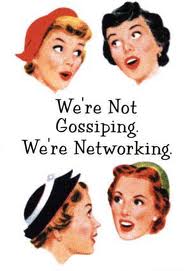When used appropriately, gossip can be an influential interpersonal communication tool and a lighthearted way of spreading information. As luck would have it, the same concept that creates bonds and builds relationships can often rear an ugly head.
According to Wikipedia, gossip is idle talk or rumor, especially about personal or private affairs of others. The term is often used to specifically refer to the spreading of dirt and misinformation, as (for example) through excited discussion of scandals.
Nigel Nicholson of Psychology Today magazine recognizes, “there are three very essential functions of gossip: networking, influence and social alliances.” It’s also been said that gossip is a way of having intimate conversation between those with similar style, personal and domestic or workplace scope and setting, while providing the comfort of validation and camaraderie. The challenge becomes drawing (and to keep from crossing) the line between sharing information and being hurtful to the reputation of yourself and others.
 Learning to balance over that line with the ease of an expert takes conscious effort and a careful attention to detail. Simply calling gossip “networking” introduces the risk of overlooking (or straight-up ignoring) the dangers that lurk in the workplace. Unfortunately, it seems that the cons outweigh the pros in this potentially harmful practice.
Learning to balance over that line with the ease of an expert takes conscious effort and a careful attention to detail. Simply calling gossip “networking” introduces the risk of overlooking (or straight-up ignoring) the dangers that lurk in the workplace. Unfortunately, it seems that the cons outweigh the pros in this potentially harmful practice.
The CONS of Workplace Gossip
- Spreading wrong information
- Loss of productivity and habitual wasting of time
- Erosion of trust and morale
- Divisiveness among employees as people take sides or “gang up on others”
- Increased anxiety among employees as rumors circulate without clear factual evidence
- Hurt feelings and reputations; feeling attacked or targeted
- Being perceived as unprofessional
- Disrespect toward supervision
- Disconnect to company brand loyalty
- Turnover increases due to good employees leaving what they perceive as an unhealthy work environment or atmosphere.
- Costly Legal Ramifications: bullying, libel, hostile workplace and harassment case filings
How Can I Avoid Gossiping at Work?
Following some basic guidelines to gossip will allow for maintaining strong bonds OUTside the workplace without sabotaging accomplishments IN the workplace.
- Never engage in gossip that is purely associated with malicious content and intent. To hurt someone else does not make you the better person. Ever.
- Avoid disclosing pay rates and earnings information. It is no one’s business what you make, just as it’s not your business what anyone else makes. Similarly, discussion about whether or not you find your boss’ pay fair and reasonable is completely inappropriate.
- Don’t discuss social plans or un-work-related activities during a shift, meeting or company function. To portray yourself as anything less than focused on your work is a disservice to those who are. Off-site and off-shift (ie., home, parking lot or on your cell phone after hours) are more appropriate times and places for social conversation.
- If you question a co-worker’s opinion or decision, discuss it with them in private. Never challenge, embarrass or deface someone’s character in front of an audience of mutual peers or associates. The term “peer” indicates a certain level of respect.
- Obtaining a good lead or gaining insider commentary is a benefit of communication with friends, but can lead to loss of trust from your associates and coworkers when you are careless with their tips.
- Never recite, even in jest, a friend or co-worker’s social misadventures to your mutual work associates. We are all entitled to a personal life, as well as a private one. What happens between friends outside the office should stay there. Far too often, juicy stories can result in the loss of respect from fellow peers and associates for the both of you.
- If irreconcilable differences do occur, keep in mind that while your out-of-office relationship (romantic or otherwise) may be over, chances are you still need to work together to some degree. Be sure to cut ties in a clean and professional manner and bear in mind that no one needs to know what happened between you. We don’t always have to like the people we work with, but we DO have to do our jobs to the best of our ability.
Other networking success resources:
- What Does Your Handshake Say About You?
- The Six Commandments of Sock Charming
- Will the Real You, Please Stand Up
Have I missed some pitfalls of gossip in the workplace? Please share your advice on keeping positive communication a priority at work…









 More than you know. Your handshake is a large part of the first impression you leave with people. What kind of hand-shaker are you?
More than you know. Your handshake is a large part of the first impression you leave with people. What kind of hand-shaker are you?

